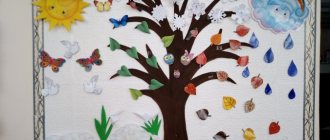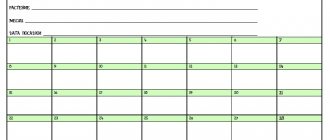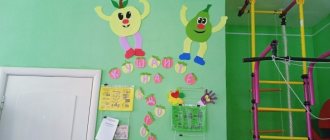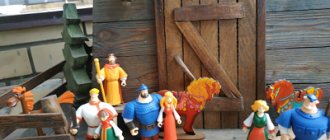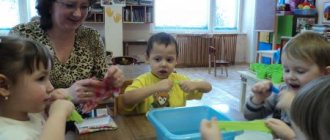PROJECT “TO CREATE A TRANSFORMABLE SUBJECT-DEVELOPMENT ENVIRONMENT IN A PREPARATORY GROUP.”
Municipal budgetary preschool educational institution "Kindergarten No. 49"
PROJECT
“TO CREATE A TRANSFORMABLE SUBJECT-DEVELOPMENT ENVIRONMENT IN A PREPARATORY GROUP.”
Developed by:
Druzhinina Elena Alexandrovna
Berezniki, 2017
1
.Relevance of the project: The problem of the RPPS group does not fully meet the requirements of the Federal State Educational Standard for Educational Education, and does not fully realize the educational potential of the group space.
To create a subject-development environment that is adequate to the program being implemented, corresponding to the characteristics of the pedagogical process and the creative nature of the child’s activity, this will effectively contribute to the formation of the basis of children’s personal culture, the development of their individuality with various spheres of culture. The transformability of space implies the possibility of changes in the subject-spatial development environment depending on the educational situation, on the changing interests and capabilities of children. The idea of mobility and dynamism can be easily realized with the help of a screen. It allows children to escape from the world of adults and settle in their own “nest”. For this, easily movable multifunctional screens and movable furniture (modules) are used. To interest parents in organizing a subject-development environment. Project type: Variable, practice-oriented 2.I
stage – Stages of work on creating RPPS 2.1.At the first stage, we studied the regulatory documents: Federal State Educational Standards Law on Education 1.In accordance with paragraph 6 of part 1 of article No. 273-F3 “On education in Russian Federation".
2.Order of the Ministry of Education and Science of the Russian Federation.” October 17, 2013 No. 1155. On approval of the federal state education standard for preschool education. Vasilyeva's program. 3. the law “On Education” of SanPiN, the program that is implemented in the preschool department, the Federal State Educational Standard, etc., each teacher creates conditions for children to stay in the group. Thus, when creating the RPPS DU, it is necessary to make changes in accordance with the Federal State Educational Standard according to the requirement of transformability. 2.2 The second stage of work was the monitoring of the PPRS for compliance with the transformability requirement. Self-assessment cards with specific indicators characterizing the quality of the RPPS were developed. Based on the results of the self-assessment, the RPPS made the following conclusions: - it is not sufficiently accessible for changes by the children themselves, - there is a lack of centers taking into account the gender characteristics of children and the conditions for constant changes in the environment. — insufficiency of modern equipment, toys, and equipment for the development of preschool children. Thus, a number of problems were identified: - there is insufficient modern interactive equipment - it is not always possible to transform the space depending on the educational environment. Based on the analysis of the subject-developmental environment of the preschool educational institution and to solve the identified problems, we developed the project “Model of a modern developmental subject-spatial environment in a preschool institution in accordance with the Federal State Educational Standard”, the goals, objectives, content of activities and activities within the framework of the project were determined, distributed responsibilities of participants in the educational process. Goal: creating conditions for the full development of preschool children in all educational areas of the Federal State Educational Standard in accordance with the requirements of transformability. Project objectives:
1. Studying problems and setting project goals.
1. Modernization of the group environment, creation of components of a single individualized space. 2. Optimization of the playing space; rational location of centers for different types of children's activities. 3. Preparation of materials on the project topic: creation of a material base for methodological support of the project (photo materials, list of references, methodological recommendations for educators, selection of material for working with parents. 4. Study of sanitary standards and requirements. 5. Selection of optimally acceptable design options group room. 7. Study of literature on the topic: “Modern requirements for the creation of a subject-development environment in a preschool educational institution." Participants: teachers, parents, preparatory group students. Scale: short-term (3 months). Project implementation plan:
“Transformability of space in kindergarten”
Transformability of space in kindergarten
Transformability of space -
the possibility of changing the subject-spatial environment depending on the educational situation, including the changing interests and capabilities of children.
When organizing direct educational activities, you need to use mobile material, which is constantly varied and modified, which allows you to enrich the plots of games and diversify the educational space of the group. Objects and toys with which a child acts are not just objects of his attention, but means of communication with adults and children.
The principle of transformability of the environment in groups is implemented through variability depending on the age characteristics of children, the period of study, and the educational program being implemented.
Transformability principle
1. It is necessary to have lightweight structures
, modules, screens, tents, light benches, modular furniture, curtains and other devices that can be easily changed functionally. For example: the teacher pulled back the curtain, and then closed the topic of the project with clarity - and this visual material does not prevent the children from concentrating on designing, and children can easily design the same curtain as a “billboard” for their activities or use it for an exhibition of their works). These same designs will allow children to independently arrange the space at their own discretion, to choose, equip or inhabit it at their own discretion, to build their own little world. This is especially true for imaginative play. The possibility of transforming space, including that performed by children, can also be realized through the use of sliding (and unrolling roller) partitions.
2. Furniture height
in kindergarten it should be easy
to change.
You need to get away from:
- Wall decoration and decorative elements should be changeable and understandable to preschoolers;
- fixed front arrangement of tables and chairs;
- stationary placement of gaming corners for story games with fixed themes and plots (“Kitchen”, “Hospital”, “Shop”, “Hairdresser”. The content of the gaming corner should be more mobile and regularly updated.
The construction of a subject environment is the external conditions of the pedagogical process that make it possible to organize the child’s independent activity, aimed at his self-development under the supervision of an adult. It is important that the subject environment has the character of an open, non-closed system, capable of change, adjustment and development. In other words, the environment is not only developing, but also developing. Practice suggests that it is difficult to completely replace the subject environment in a group. But still, under any circumstances, the objective world surrounding the child must be replenished and updated. Only then does the environment contribute to the formation of cognitive, speech, motor and creative activity.
The environment should provide light, movable, portable structures that enable children to create space for play in a convenient place - platforms on wheels, small podiums on wheels, portable playground corners made of a plastic base, which can also serve as screens.
The idea of mobility and dynamism can be easily realized with the help of a screen. It allows children to escape from the world of adults and settle in their own “nest”.
Transformable screens have been made for games: (steamboat, car, military vehicle, girls' room), which allows you to use gaming equipment in different ways. Screens have two and three doors, they are light and safe to use.
The “Machine” screen can serve as a plot for games and allows the child to limit his play area. The wheels and awning of the machine are removable, which makes it easy to store the screen.
The “Boat” screen for boys can have an angular shape. A child can upgrade it with the help of attached paraphernalia, and marine-themed items (anchor, steering wheel, lifebuoy) will help quickly organize the game.
It is enough to replace the fabric covering and it is no longer a ship, but a military vehicle or a headquarters for commanders. Children can act on their own depending on the game plan. Screens for boys allow you to change the subject-spatial environment and introduce new things into it in accordance with the interests of the children. All the boys' favorite items can be easily attached and placed in their pockets: watch, walkie-talkie, flashlight, map, binoculars. They also easily accommodate carpentry and joinery tools: a hacksaw, a hammer, a screwdriver. And the flirtatiously elegant screen for girls seems to emphasize the serious nature of the boy’s screen.
Screen for girls can
made of a light veil, which is gathered so that it resembles the shape of a light airy skirt. The screen is complemented with attributes for a little lady (chest, hat, beads, umbrella).
The screens are convenient to store and easy to fold, allowing you to carry them. Screens are multifunctional and versatile.
Soft modules enrich children's play and provide transformability and multifunctionality of the play space. At the discretion of the players, it can be a rocket, a swimming pool, a palace, a bus, etc.
The fullness of the subject-developmental environment allows children to experience an event each time in a new situation, environment, which develops fantasy and imagination, allows them to master the means of communication and ways of interacting with adults and peers.
Making the playing field:
“Forest glade”, equipped with a set of small toys that can be used in different settings (farm, village, park, etc.), in accordance with the children’s play plans. Children can add ready-made models or build the necessary structures from various construction sets, use substitute objects, and homemade toys.
“The Road” helps to consolidate and embody children’s personal social experience in the game, immersion in the game situation, showing ingenuity in using the subject environment, performing a variety of game actions, and complementing the game environment as the game progresses.
“Variability and transformability of space.”
Variability of the subject-spatial environment, its transformability and multifunctionality
The priority of general cultural and personal development stated in the Federal State Educational Standard means that preschool education should be focused not on formal performance, but on supporting the child’s ability and self-realization. No educational and educational influence on a child can be carried out without the actual activity of the child himself. To satisfy his needs, a child needs the environment that he perceives at a certain moment in his development.
A developing subject-spatial environment is an effective means of shaping a child’s personality. Taking this into account, the primary task of the teaching staff is to create a subject-development environment that should involve children in the educational process and provide maximum psychological comfort.
According to the Federal State Educational Standard for Preschool Education, the development of the subject-spatial environment of our kindergarten is formed taking into account the following principles:
1. Saturation
The richness of the environment corresponds to the age and individual capabilities of the children and the content of the Program.
The educational space is equipped with teaching aids, various materials, including consumables, gaming, sports and health equipment.
Subject content performs informative functions about the world around us and transfers social experience to children. All toys and equipment are varied.
Games are of varying degrees of complexity, which provides high developmental potential. Use of gender games and toys for girls and boys.
(artistic - aesthetic, cognitive - speech, physical)
We take into account the individual characteristics of children and use games of different difficulty levels.
Emotional well-being of children in interactions with the object-spatial environment and the possibility of children’s self-expression.
2. Transformability
The transformability of space implies the possibility of changes in the subject-spatial environment depending on the educational situation,
including the changing interests and capabilities of children. (Tables trapezoid, daisy, square, rectangular, petals)
Thanks to transformable beds, we use the space of the bedroom for physical activity and individual development.
Activity centers are easily transformed depending on the educational situation.
Operational change of space is necessary for the full functioning of the development of the subject-spatial environment.
For example: on the site of a natural corner you can organize (a creative laboratory, a workshop, a museum, a trip).
The groups have natural corners - they can be transformed into a laboratory, a patriotic corner, an exhibition of children's creativity.
In the educational process, it is possible to transform tables (combine, individually).
In the bedrooms, it allows you to use the space for physical activity of children and for individual work.
3. Multifunctionality
Multifunctionality implies the possibility of varied use of various components of the object environment, children's furniture, soft modules, mobile bookshelves, game markers.
Multifunctionality allows the child to flexibly use elements of the development of the subject-spatial environment in accordance with his plan and the plot of the game.
The presence of multifunctional objects, including natural materials, for use in various types of children's activities, including as substitute objects.
We use the educational board for drawing with markers, making patterns, and an exhibition of children's works.
All gaming equipment is used in group games, including with the participation of an adult.
For example: Game markers can be used in a children's game according to the child's plan (Shop, bank, bus made of chairs).
4. Availability
The Federal State Educational Standard takes into account the accessibility for preschoolers of all premises where educational activities are carried out; (Music hall, art studio, speech therapist’s office, teacher-psychologist’s office, preschool educational institution museum, playgrounds, gym.)
children’s free access to games, toys, materials, and aids that provide all basic types of children’s activities;
5. Variability
The variability of the environment presupposes the presence in a group of different spaces of a variety of materials, games, toys and equipment, ensuring the free choice of children.
Kindergarten groups are conventionally divided into activity centers: a center for literature, science and nature, an artistic and aesthetic center, and a mathematics center.
In the centers, periodic rotation of play material and the appearance of new objects stimulate the play, motor, cognitive and research activity of children. In addition, it is possible that centers of interest will appear (mini-museum and individual exhibitions for children)
Due to their high developmental potential, gaming tools are used for children with different levels of development. The higher the potential, the higher the development opportunity.
6. Security
The safety of the subject-spatial environment presupposes the compliance of all its elements with the requirements for ensuring the reliability and safety of their use.
In order to organize meaningful activities for preschoolers, excellent shady canopies are equipped outdoors that meet the requirements of SANPin.
The variability of the subject-spatial environment and its transformability and multifunctionality makes it possible for preschoolers to independently organize their own activities, show cognitive activity and interest.
